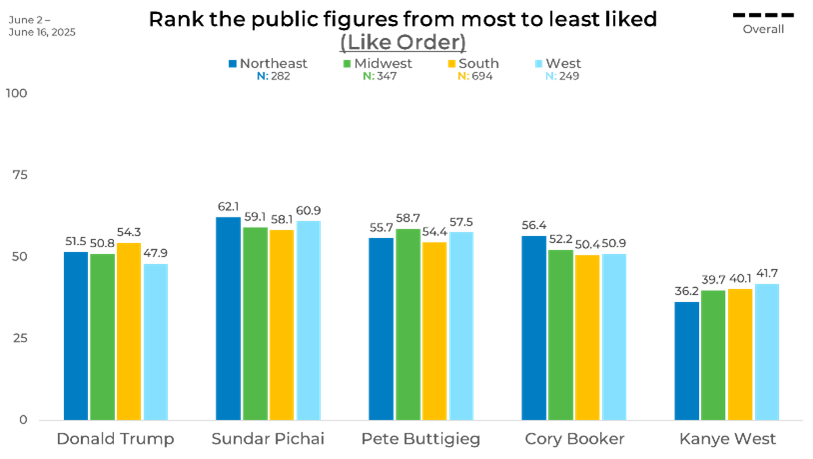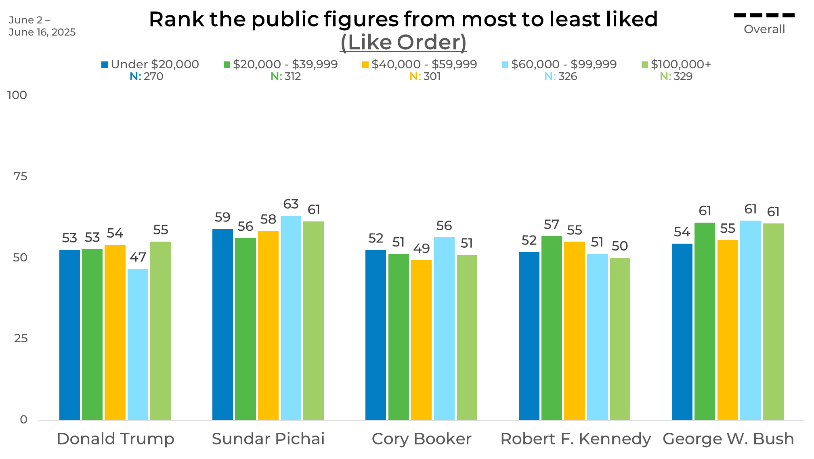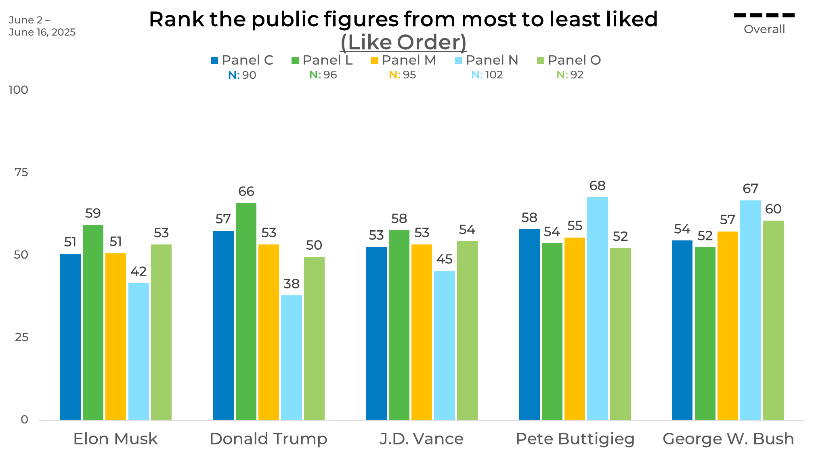
Tariff Tension: Americans’ Concern Over Changing Policy
July 29, 2025
Fall Conference Season and a Potential Privacy Turning Point
August 12, 2025Measuring public sentiment toward well-known figures isn’t always straightforward. Depending on the method used, preferences can show subtle differences or reveal sharp divides. In our recent round of research-on-research, we explored two different methods: MaxDiff and Like Order.
We had half of the participants completed a Like Order exercise, where they ranked all public figures from most to least liked, while the other half completed a MaxDiff task, selecting the most and least liked from smaller sets. This split allowed us to explore how each method captures public perception. Here are the individuals included:
- Elon Musk (CEO of Tesla and SpaceX)
- Donald Trump (Current U.S. President)
- J.D. Vance (Vice President of the U.S.)
- Mark Zuckerberg (CEO of Meta Platforms)
- Sundar Pichai (CEO of Google)
- Pete Buttigieg (Former U.S. Secretary of Transportation)
- Cory Booker (U.S. Senator, known for 24-hour filibuster)
- Luigi Mangione (Business executive facing federal murder charges)
- Robert F. Kennedy Jr. (U.S. Secretary of Health and Human Services)
- Sean “P. Diddy” Combs (Musician facing legal challenges)
- Kanye West (Musician, fashion designer, and entrepreneur)
- George W. Bush (Former U.S. President)
Both methods offer valuable insights, but the contrast between them helps paint a more complete picture. Since the Like Order and MaxDiff formats use different scoring ranges, we normalized the Like Order results to match the MaxDiff scale, allowing for direct comparisons across methods.
Overall
Some public figures consistently scored near the top, while others were more polarizing, and the two methods often shifted the order. George W. Bush topped MaxDiff at 62.7 but placed third in Like Order at 58.9. Sean “P. Diddy” Combs and Kanye West ranked lowest in both, though MaxDiff nudged their scores slightly higher—28.6 vs. 26.1 for Combs, and 45.2 vs. 39.6 for West—indicating pockets of stronger support. Sundar Pichai and Pete Buttigieg performed strongly in both systems, but Pichai’s score was 57.3 in MaxDiff versus 59.5 in Like Order, while Buttigieg held 54.6 and 56.1 respectively. MaxDiff’s compressed scale magnified the contrasts, making the spread between high and low performers more apparent and highlighting figures with more polarized sentiment.


Side by Side
This side-by-side comparison shows not only where the two methods aligned but also where they painted noticeably different pictures. MaxDiff generally compressed the overall range, tightening high scores and lifting lower ones, which made the spread between top and bottom performers more distinct. For example, Donald Trump and Elon Musk each saw about a 4–5 point drop when moving from Like Order to MaxDiff, reflecting less uniform support across the sample. Conversely, Luigi Mangione gained nearly 5 points, moving from 38.4 in Like Order to 43.0 in MaxDiff, indicating stronger intensity among a smaller base of supporters. Figures like Mark Zuckerberg and Sundar Pichai also saw modest declines in MaxDiff, showing that while their overall favorability was high, the strength of feeling behind those ratings was slightly more muted compared to others.

Gender
Women rated Donald Trump and Elon Musk significantly lower than men in both methods, with Trump showing a 7–10 point gap depending on format: scoring around 56–57 with men in Like Order versus 48–49 with women, and similar drops in MaxDiff. Elon Musk’s ratings showed a smaller but still notable gender gap, with men rating him roughly 6–8 points higher in both methods. Pete Buttigieg and George W. Bush scored higher among women, particularly in MaxDiff, where Bush gained several points, moving from the mid-50s among men to the mid-60s among women. Men were more consistent in their preferences overall, but MaxDiff still revealed sharper positive intensity for Musk, with male scores pushing him a few points higher compared to Like Order.


Political Affiliation
Republicans gave Donald Trump over 80 points in Like Order (82.8) and slightly lower in MaxDiff (75.7), while Democrats rated him much lower, in the low 20s for both methods (23.7 in Like Order, 23.2 in MaxDiff). Pete Buttigieg showed the reverse pattern: Democrats placed him in the high 60s (68.9 in Like Order, 67.1 in MaxDiff) and Republicans rated him in the low 40s (41.9 and 42.8 respectively). Independents generally rated figures more moderately—Trump around 49.7 in Like Order versus 40.4 in MaxDiff, and Buttigieg at 57.9 in Like Order versus 55.9 in MaxDiff—though the MaxDiff format exposed more extreme opinions, narrowing middle-ground sentiment and emphasizing intensity on both ends.


Region
Trump’s support peaked in the South in both methods, scoring in the mid-50s there, but MaxDiff lowered his Northeast rating by about five points compared to Like Order (46.3 in MaxDiff vs. 51.5 in Like Order). Sundar Pichai’s regional ratings were steady—generally in the high 50s across all areas—though Like Order placed him slightly higher in the Northeast at 62.1 compared to 56.6 in MaxDiff. Pete Buttigieg saw a boost in the Midwest using Like Order (58.7) versus MaxDiff (56.6), while MaxDiff narrowed the gap between regions, making his performance appear more consistent nationally.


Age
Younger respondents rated Luigi Mangione and Elon Musk higher, especially in MaxDiff where Mangione’s score rose from 38.4 in Like Order to 43.0—a gain of roughly 5 points—with similar small boosts for Musk. For older groups, George W. Bush’s popularity was even more pronounced, scoring in the low 70s among those 65+ in both methods, with MaxDiff widening his lead over younger respondents by as much as 15 points. Sean “P. Diddy” Combs showed a small youth boost as well, moving from the mid-20s in Like Order to slightly higher scores in MaxDiff among respondents under 35, though he remained near the bottom overall.


Income
High-income respondents consistently rated Sundar Pichai (around 61 in Like Order, 57 in MaxDiff) and George W. Bush (low 60s in Like Order, high 50s to 60 in MaxDiff) highest, with Bush gaining a few extra points in MaxDiff among the top income tier. Trump’s Like Order ratings dipped in the $60,000–$99,999 bracket (47) compared to other brackets, while his MaxDiff scores were steadier, ranging from 43 to 52 across income groups. Middle-income groups gave Cory Booker higher Like Order ratings (up to 56), though MaxDiff smoothed out those peaks, keeping him closer to 51–54 across the board.


Ethnicity
Caucasian respondents rated Trump about 12 points higher than African-American respondents in Like Order (55.0 vs. 41.0), and the gap widened slightly in MaxDiff (50.0 vs. 38.0). African-American respondents rated Kanye West and Sundar Pichai higher in both methods, with MaxDiff especially boosting Kanye’s standing from 50.0 in Like Order to 53.0. Sundar Pichai’s ratings were strong across all ethnicities, reaching as high as 68.0 among Asian respondents in Like Order and 66.0 in MaxDiff. Hispanic respondents gave Luigi Mangione stronger MaxDiff ratings compared to Like Order (50.0 vs. 49.0), showing modest but noticeable variation between formats.


Panel
Panel differences were notable and often revealed sharper contrasts between the two methods. Pete Buttigieg, for example, scored in the high 60s in Like Order for Panel N (68) but was closer to the mid-50s in MaxDiff (55), indicating less intensity when using the forced-choice format. Trump’s ratings swung widely by panel in both methods, with differences of up to 20 points—Panel L rated him over 65 in Like Order but closer to 45 in MaxDiff, while Panel N showed the reverse pattern. Elon Musk’s Like Order scores peaked in Panel L at 59 but dropped into the low 40s for Panel N, yet in MaxDiff his scores were more consistent across panels, staying within a 7-point range. These shifts highlight how MaxDiff can smooth panel variability, underscoring the benefit of blending results to achieve a balanced view.


To learn more about how EMI’s strategic sample blending can ensure high-quality conclusions from your next survey, click the button below.




